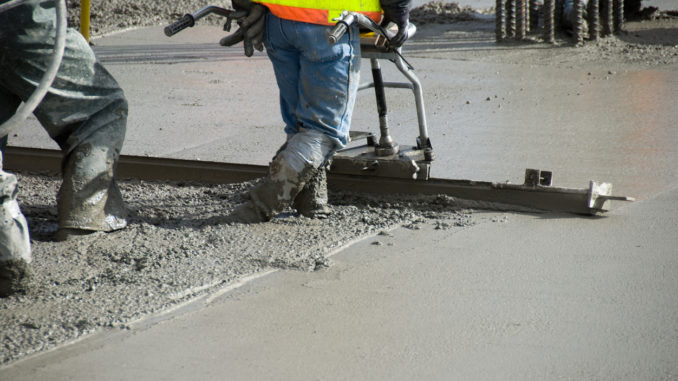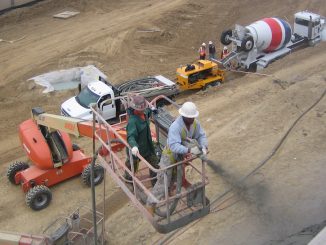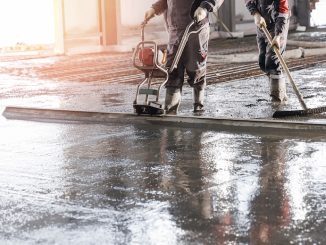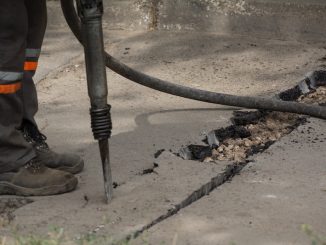
View the complete article here.
A basic concrete mix always includes common materials: an aggregate filler, mixed with water, air, and cement to bind the mixture. Even though it is a simple combination, there are times when additional chemicals or materials are used to improve the performance of the pavement. The chemical combination of the mixed products has an impact on the lifespan and behavior of the paved surface.
These extra materials might include a support system and reinforcements, such as tiebars, dowel bars, and more. Additionally, it can be helpful at times to use curing compounds on the surface of the cement. In this article, we are going to look at a range of supplementary cementitious materials (SCMs) and factors that need to be considered to achieve the right mix for each project.
Overview of Hydraulic Cement
When a mixture is designed to be a hydraulic cement, then it means that the materials harden and set after coming in contact with water. These materials are often used when concrete needs to be placed under water.
Two common types of hydraulic cement might be used:
- Portland Cement
- Blended Cement
Availability of concrete mixes might depend on the area where the cement is sourced. If a specific type is needed but it isn’t available, then it is common to combine another cement type with specific SCMs. The goal is to meet the anticipated requirements for the environmental factors, such as a lower heat of hydration or high early strength.
An Overview of Supplementary Cementitious Materials
Over 60% of the cement mixes in the US supplement Portland cement with SCMs. This practice is growing in popularity for several reasons. SCMs are usually cost-effective since they are often by-products of other industrial processes. Additionally, the chemical components are similar to the makeup of Portland cement. Not only can SCMs be used for the technical benefits, but they are also beneficial for energy and environmental conservation.
For many years, SCMs were used individually in concrete mixtures. Now, a combination of SCMs can be used to optimize the properties of the pavement. Common SCMs might include:
- Fly Ash: The most widely used SCM, added to about half of the ready-mix concrete products in the country. This material usually decreases the amount of water that is needed for workability. Expect a longer setting time with reduced early strengths. But, the later strengths are increased, and permeability is reduced. The classification of the fly ash will affect the mass amount used in the cementitious materials.
- Ground, Granulated Blast-Furnace Slag (GGBF): Also known as slag cement, this SCM allows the cement to hydrate without the need for extra calcium. Slightly less water is needed. One of the main benefits is the significant improvement to chloride penetration. GGBF slag often accounts for as much as 35% of the material used for paving mixes.
- Natural Pozzolans: These SCMs are helpful for the process of converting calcium hydroxide to calcium silicate hydrate. The materials are heat-treated before being ground to a powder for the cement mixture. They can comprise between 15% and 35% of a concrete mixture, helping to improve the resistance to sulfate attacks, reduce permeability, and improve strength development.
- Other Pozzolans: Sometimes other byproducts are used, such as rice husk ash. These materials typically don’t fall under the categories that are used for other materials.
- Silica Fume: This material isn’t often used because it is expensive and can have a negative impact on the workability of the concrete. It is usually reserved for special applications, such as gutters, curbs, or roads that will be impacted by studded tires.
How Supplementary Cementitious Materials Affect Concrete Performance
The properties of the concrete can be greatly affected by the SCMs that are used in the mix. Some of these desirable effects are the reasons why contractors choose to add SCMs. Although, there are accommodations that need to be made for the side effects that are less than desirable. It is important that trial batching is completed if you are using unfamiliar combinations or materials.
Here are some of the possible performance factors that might be experienced with the use of SCMs:
- Fresh Cement: The workability of the fresh cement is always affected by SCMs, either increasing or decreasing workability based on the ratio of the mixture. Also, the rate of stiffening could be increased when chemical incompatibilities are present.
- Permeability and Durability: Reducing permeability is a desired trait to improve the long-term durability of the pavement. Most durability concerns are related to the fluids that can move through the concrete. If the water-cementitious materials are decreased, and the hydrated cementitious materials are increased, then the permeability of the cement is negatively impacted. Adequate curing, mixing, and finishing practices need to be used to improve durability.
- Reactivity Resistance: It is important to consider the alkali-silica reactivity (ASR) and how the SCMs will affect this reactivity. Certain types of fly ash can be helpful to reduce the reactivity, but other types can increase ASR.
- Sulfate Resistance: External sulfate attack can be reduced by using specific SCMs. As the permeability is reduced and the reactive elements are decreased, then it slows the sulfate reactions.
Aggregate: The Bulk of the Concrete System
Rocks and minerals, known as aggregate, created the filler for the concrete system. These products are dimensionally and chemically stable, which means that it is usually best to maximize aggregate in the mixture as much as possible. The general composition is a mineral-based substance or rock, often sourced from natural locations in seabeds or river beds. Aggregate materials might include:
- Carbonate Rock
- Granite
- Sand and Gravel
- Manufactured Aggregate Materials
- Recycled Aggregate Materials
While aggregate has a strong influence on the workability and durability of the paving, it is important that the right grading techniques are used to reduce the space between the aggregate particles. This space will be filled with cement paste that is chemically reactive, and it also plays a part in the amount of water that is needed for workability.
The most common types of aggregate used for concrete paving are limestone and granite. It is important to choose aggregate that is durable, helping to minimize the potential damage due to frost, chemical reactions, and salt.
As with all types of cement, it is suggested that trial batches of cement be produced with the aggregates to determine the optimal characteristics of the mix.
Water Mixing for Cement Durability and Performance
The source and quality of water can have an impact on the workability and performance of the cement mixture. This mixing water might be brought in from different sources:
- Ice
- Batch water
- Free moisture on the aggregates
- Water in the admixtures
- Water added after the initial mixing is complete
The best solution is to use potable water since excessive impurities can impact the quality of the concrete. But, there is an acceptable level of using recycled water that comes from plant washing and returned concrete that might be used.
If you are planning to use questionable water for mixing, then it is always good to test the system in a batch run before completing the paving project. This testing can help to determine the setting time and concrete strength.
Chemical Admixtures
These materials are used in concrete mixtures to change the properties, such as setting time, water requirement, and air content. Good practice and proportioning of the main materials should always be used, with admixtures helping as a complementary addition.
It is common for unintended side effects to occur, which is why trial batches should always be completed using the same materials and conditions. A general rule of thumb is that about 5% of the compressive strength will be lost for every 1% of entrained air, which needs to be considered when comparing the results of air-entraining admixtures with options for set-modifying or water-reducing admixtures. Always look for possible incompatibilities when chemical admixtures are used.
Concrete Reinforcement: Dowel Bars, Tiebars, and More
Adding reinforcement can be helpful to transfer loads across joints and improve the performance of how the paving handles the stresses that can pull the concrete apart. Various materials can be used based on the individual needs of each project:
- Dowel Bars: Also known as smooth bards or dowels. Often placed across transverse joints. The goal is to create vertical support so that the loads are transferred across the joints.
- Tiebars: These materials are commonly known as deformed bars or rebar. Used for longitudinal joints where the slabs meet, helping to reduce the risk of the slabs separating.
- Slab Reinforcement: Can be used to help with carrying the tensile stresses. These reinforcements will hold the pavement together regardless of transverse cracks that might develop.
Various materials can be used for these reinforcement products, such as steel, epoxy-coating bars, stainless-clad bars, fiber-reinforced polymer, synthetic fibers, stainless steel pipes, and more.
Curing Compounds for Cement Mixtures
After the concrete is textured, it is important to use curing compounds that are applied to the surface of the concrete. This process is beneficial to reduce the moisture loss that occurs on the surface. There are various types of curing compounds. But, the most common compounds are materials that are liquid membrane-forming.
Consistent, even application is important so that the surface is covered completely. Often, the curing compounds are pigmented to see the uniformity of the application. For example, if the curing compound will be placed on a hot, sunny day, then a white pigment is used to reflect the heat of the sun. Even though the pigment is visible during application, it usually fades soon after application.
View the complete article here.
What are Supplementary Cementitious Materials (SCMs), and why are they used in concrete mixes?
SCMs, such as fly ash and ground granulated blast-furnace slag, are additives in concrete mixes to enhance performance, reduce costs, and contribute to environmental conservation.
How does water quality affect concrete durability, and what are the recommended sources of mixing water?
Water quality influences workability and performance; it is recommended to use potable water, with recycled water accepted within limits, to ensure optimal concrete quality.












































